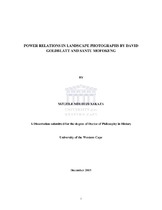| dc.description.abstract | How far can landscape photographic images allow us to interrogate the extent to which collective socio-political, cultural and economic aspirations of marginalised South Africans have, or have not, been achieved since the dawn of democracy in 1994? In thinking about such aspirations, I posit that the victims of colonialism and the Apartheid system had expectations of living in a free, non-racial South Africa where equality would be realised in political, social, cultural and economic spheres. However, I use landscape as the basis for determining the extent to which such aspirations might or might not have been achieved within the context of post-Apartheid South Africa. What role can the work of David Goldblatt (born 1930) and Santu Mofokeng (born 1956) play in facilitating our ability to read a post-Apartheid diagnosis regarding this question? These issues are the primary focus of this thesis, and connect to a range of other questions. For instance, what methodological approaches do these practitioners employ in framing their
photographed landscape scenes, be they populated or depopulated? Why is landscape in the centre of this thesis, and why are these practitioners considered relevant in the context of this study irrespective of their disparate racial and cultural backgrounds? The main body of the thesis traces these photographers’ individual methodological approaches, distinguishing them from predominant modes associated with the Afrapix Collective (1982-1992) and the later Bang-Bang Club (1990-1994). It locates them within the context of ‘struggle photography’ with which the Afrapix members and the Bang-Bang Club were primarily concerned. The Bang-Bang Club in particular had a preoccupation with the framing of violent scenes that ensued in the South African political arena during the early 1990s, leading up to the national democratic elections in 1994. My argument centres on what I consider the main element that distinguishes the practitioners in question from the Afrapix and the Bang-Bang Club – the everyday. I explore how specific examples of Goldblatt’s and Mofokeng’s focus on the everyday contribute to an articulation of the role of landscape as a medium of social critique. Instead of framing sensationalist and newsworthy episodes of violent political strife within pre-1994 South Africa, Goldblatt’s long career traces the underlying causes of the
social injustices and resultant power contestations while Mofokeng, who was also a
member of Afrapix, looks at what I term the spiritual or ethereal elements within
landscape. It is this subtlety in their approach that sets them apart from their counterparts as they use landscape as a kind of proverbial text in which we can ‘read’ human actions over time. Thus time and space are inevitably significant in the study of these photographers’ oeuvre. But what do all these elements have to do with the challenging question of land in South Africa? What do they have to do with the construction of the South African landscape? What is the role of the camera in that construction? Using photographic images as important tools, I place the land issue, especially as it is mediated through landscape construction, at the centre of my interrogation of power relations in Apartheid and post-Apartheid South Africa. | en_US |

